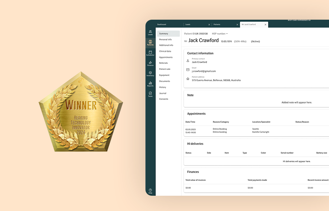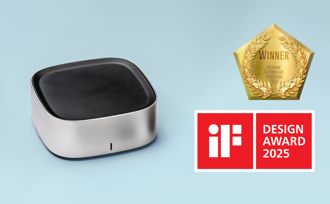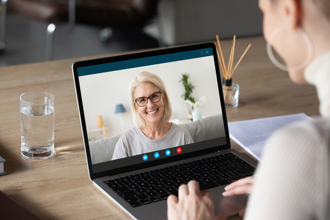
In the fast-paced hearing care industry, clinicians are busy every day, seeing patients, updating charts, and working to hit key metrics. It’s common for them to multi-task, and many practitioners may (intentionally or unintentionally) rush through patient appointments, not fully listening. That’s a mistake, as active listening in hearing care is essential to providing patients with Best Care Experiences.
Active listening means that you – as the clinician – commit to being fully present, focusing on the patient in front of you, and not simultaneously checking your texts, rushing off to your next appointment, or thinking about your next patient. This blog will explain the importance of active, engaged listening in audiology – and how it benefits patients, their families, clinicians, and hearing clinics.
Active Listening in Healthcare: Hear and Understand Your Patients

As a hearing care professional, you’re frequently under pressure and time constraints, seeing many patients daily. But it’s important to remember that your communication style—and willingness to really listen to your patients—will impact your relationship with them and their willingness to work with (and listen to) you.
How do you know if you are an active listener?
- Are you focused on your patients, paying attention to what they say?
- Are you asking thoughtful follow-up questions to clarify what they’re saying?
- Do you ensure that your patients are engaged in conversations with you?
- Do you notice each patient’s body language and facial expressions?
- Do you avoid toggling back and forth between your computer screen and conversations with your patients so you’re not distracted?
- Do you make each patient feel heard, validated, and appreciated?
Hopefully, you answered “yes” to all these questions, which shows you’re an active listener. Active listening in healthcare is so important, as it shows empathy for your patients and demonstrates your eagerness to engage in collaborative care.
Hearing vs. Active Listening

There’s an important difference between hearing and listening. Hearing is the fundamental physiological process of perceiving sound. For many people, hearing is often done passively, without really paying attention. Unlike hearing, active listening is an intentional process – paying thoughtful attention and trying to fully understand the messages being delivered.
As an audiologist, you must do more than just passively hear each patient’s words. You must actively listen to what they’re saying, while also paying attention to their non-verbal clues, like body language and facial expressions. Together, this will help you more accurately assess what’s happening with your patients and improve customer relationships.
The benefits of active listening in hearing care includes:
- Earning trust and boosting confidence. When audiologists and their patients are engaged and connected, patients are more likely to share their concerns, be honest about their symptoms, ask questions, and be willing to accept the clinicians’ recommended solutions. Active listening can help secure patients’ trust and confidence. Conversely, poor communication can damage the patient-provider relationship, causing patients to avoid seeing you again, not buy hearing aids from you, and switch to other clinics.
- Improving care. Active listening can help providers pick up on what a patient is saying – and also what they’re not saying. Being fully focused on each patient allows clinicians to tune into their verbal and nonverbal cues to improve diagnoses and outcomes. For instance, a patient may insist they’re fine, but physical cues – like wincing in pain during an exam – can provide valuable insights beyond what they’re telling you. Active listening – plus reading each patient’s body language – can help audiologists provide better care, diagnoses, solutions, and outcomes.
- Overcoming patients’ concerns. Active listening can help you overcome patients’ concerns. Suppose a patient insists that their hearing is fine, but their spouse disagrees, explaining that the patient is having considerable difficulty hearing conversations, the television, etc. In this instance, the loved one’s perspective provides a clearer perspective, allowing you to reframe your questions and look more closely at the patient’s nonverbal cues during the exam. Perhaps the patient is resisting hearing aids because of perceived stigmas. Maybe they think hearing aids will make them look old, they’re worried about the cost, etc. Active listening can help you pinpoint – and address – the patient’s concerns.
- Reducing patients’ fear and anxiety. Often, patients are nervous about visiting a hearing clinic – especially if it’s the first time. Active listening is an effective way to support your patients and help ease their fears and anxieties. Smile, make eye contact, be compassionate, reassure them that many people feel worried, ask about their concerns, and be kind. Demonstrate – through words and actions – that you understand their concerns, and that you’re there to make them feel more comfortable. Being fully present and engaged shows that you genuinely care about the patient – which will go a long way in making them feel more comfortable and relaxed.
- Improving patient compliance. Active listening helps foster mutual understanding between patients and providers. Frequently, this results in each patient feeling more informed and engaged about their diagnosis and recommended treatment process. Therefore, they’re more likely to comply with your recommended solutions. Improved communication leads to improved compliance, which results in better patient outcomes. It's a win for the patient, provider, and clinic!
- Enhancing team performance. Active listening can provide many internal benefits for your hearing clinic, as well. It can boost staff performance, ensure teams are aligned, reduce errors, build trust, resolve conflicts, and lead to healthier working relationships in your clinic.
The Mechanics of Active Listening in Healthcare Settings

To become a better active listener, hearing care professionals should:
- Focus on Each Patient. Pay attention to each patient, and don’t get distracted by other things, like incoming texts, emails, your hectic appointment schedule, or any other tasks. While you’ll need to record data into your Practice Management Software and use tech solutions to test and fit your patients, don’t hide behind your computer when you’re talking to your customers. Use new technologies – like AI scribes and ambient listening technologies – which will allow you to focus on your patients and give them your full attention.
- Be Mindful of Body Language and Facial Expressions – Yours and Theirs. Be aware of patients’ nonverbal cues. For instance, if they talk fast or fidget, these could be signs of nervousness. If they stare intently at your mouth as you speak, they could have trouble hearing. Keep in mind that your body language is also essential. To show your patients that you’re truly open to what they’re saying, nod while they talk, smile as appropriate, don’t fold your arms, lean slightly towards them, and maintain eye contact.
- Ask Open-Ended Questions. Asking "yes or no" questions often results in “dead-end” answers, which isn’t helpful, prevents the conversation from flowing, and doesn’t provide much helpful information. Instead, ask open-ended questions to show interest in the patient’s symptoms, health history, lifestyle, etc. For example, ask: Can you tell me more about when you’re having trouble hearing? When does it bother you most? These questions signal genuine interest in the patient, making them feel valued and allowing you to understand their specific circumstances better.
- Be Patient. This is important to active listening because patience allows each customer (and/or their loved one) to speak without interruption, giving them plenty of time to say what’s on their mind. Be respectful. Don’t interrupt, try to finish their sentences, or change the subject abruptly, as this may convey impatience and be off-putting to your customers.
- Avoid Being Judgmental. Be open and create a non-judgmental “safe space” so patients are more comfortable sharing their thoughts, feelings, and symptoms with you. They’re more likely to be completely honest with you if they know they won’t be shamed or criticized. Show compassion and empathy. Demonstrate support through your words and actions, like nodding and smiling when patients confide in you.
- Summarize their Messages. After listening to your patients, paraphrase what they said to ensure that you understood them correctly. By summarizing their messages, it shows that you were listening closely. This way, if you misunderstood something, they can easily correct you.
- Request Clarification. If you didn’t understand something the patient said, ask for clarification or further explanation. If they were ambiguous or unclear, ask open-ended questions to clarify what they meant.
- Be Empathetic. Demonstrate empathy and compassion to validate patients' feelings, build trust, and develop strong, long-term relationships. This will help you better connect with each patient, which is essential to provide Best Care Experiences.
Hearing Beyond Words

Did you know that as much as 65% of a person’s communication is non-verbal? Even when someone isn’t speaking, they can still communicate nonverbally through their body language and facial expressions. Therefore, an important part of active listening in healthcare involves paying attention to nonverbal cues, like body language and facial expressions.
Nonverbal cues can send strong messages. Even if you’re making these nonverbal cues inadvertently, you could be sending your patients “mixed messages” if you’re saying one thing with your words but something different with your body language. For instance, if you’re saying, “Good morning, nice to see you” to a patient, but you’re looking at your watch or texting on your phone simultaneously, that “nice to see you” may feel completely disingenuous. Likewise, if you say you have good news for a patient, but your face has a solemn, serious expression, your patient may think the news is actually terrible.
When patients get mixed signals from you, they must decide whether to believe your verbal or nonverbal message. Since people may perceive your body language to be your “true” feelings, patients may choose to believe your nonverbal messages. Therefore, consider how your nonverbal communications appear to your patients:
- Facial Expressions. Do you smile a lot? Do you look genuinely happy to see your patients? Do you look serious or unhappy, even when delivering good news?
- Posture and Positioning. Do you sit with your arms crossed in a “closed off” position? Do you “hide” behind your computer during appointments, or do you engage and interact freely with your patients and their loved ones?
- Eye contact. Do you frequently make eye contact with your patients during conversations? Or do your eyes nervously dart around the room, refusing to connect with your patients – inadvertently conveying that there’s something to be nervous about?
- Movements. Do you look at your watch often? Do you repeatedly check your phone? Do you stare at your computer while patients are talking? These movements can convey disinterest in the patient (and the conversation), and can make patients feel like you’re rushing them, don’t really care, or are in a hurry to get to your next appointment.
Nonverbal signs of active listening include smiling, making eye contact, and leaning slightly forward towards the patient.
Your body language can either put patients at ease and build trust, or they can be off-putting, confusing, and even rude. What are your nonverbal cues saying to your patients?
Technology-Enhanced Active Listening in Audiology
In audiology, one of the key advancements has been the development of tools that support active listening, allowing clinicians to fully engage with their patients without the distraction of administrative tasks. These technology-enhanced solutions are revolutionizing how audiologists interact with their patients, enabling them to focus on providing the best possible care.
With paperless protocols and streamlined patient management, Auditdata’s Practice Management Software, Manage lets hearing care professionals focus on what matters. Manage relieves staff of manual processes and data chaos, cutting paperwork and complexity out of the daily routine. The practice management software frees time up, so hearing care professionals can focus on delivering knowledgeable and tailored care to their patients.
Auditdata Manage stands out not only for its efficiency but also for its user-friendly design that significantly enhances the clinician’s workflow. The software features guided appointment-based activity workflows, meaning clinicians don't have to waste time figuring out the next steps in the patient care process. Instead, the workflow intuitively prompts users to use the correct tab and area within the system, ensuring a seamless and efficient experience and making it easy for clinicians to remain focused on the patient.
This level of intuitiveness is also beneficial for new users, as the software’s modern design makes it incredibly easy to learn and adapt to. As a result, even those unfamiliar with the system can quickly become proficient, allowing them to stay focused on delivering exceptional patient care without getting bogged down by the technical aspects of the software. This seamless integration of workflow and usability enables clinicians to stay present with their patients, ultimately enhancing the overall care experience.
Other Blogs You Might Enjoy

What Do Your Hearing Aid Users Need?
If someone suspects they have hearing loss, they should see an audiologist for a hearing screening to determine whether they need hearing aids. But then what happens? This blog explains how to give your patients what they need for success with their hearing aids, such as setting proper expectations, providing care and maintenance tips for the devices, offering valuable tips before they buy, and providing ongoing aftercare.

How Auditdata Manage Helps You Deliver Best Care Experiences
Explore how Auditdata's Practice Management Software, Manage, enhances audiology care with advanced scheduling, personalized services, and effective aftercare. Learn to optimize every patient interaction to provide best care experiences to every patient at all times.

Customer vs. Patient – Does it Matter What You Call the People You Serve?
Should hearing clinics refer to the individuals they serve as patients or customers? Do these words matter? Could specific terminology make people feel better (or worse) about needing hearing aids? This blog explores the connotations associated with these terms.
Don't Miss Out On the Latest Insights On Audiology
Sign up today to receive exciting updates, tips, and the latest newsletters from Auditdata.
Resources
⭐️ Auditdata Manage - Practice Management Software
⭐️ How Poor Communication Destroys Your Hearing Loss Sales Efforts
⭐️ 9 Smart Ways Your Audiology Hearing Clinic Can Improve Customer Relationships
⭐️ What are the Benefits of Active Listening?
⭐️ AI scribe saves doctors an hour at the keyboard every day
⭐️ All ears: What to know about ambient clinical listening
⭐️ 6 Subtle Signs of Hearing Loss
⭐️ Practice Makes Perfect: Techniques for Better Listening in Healthcare




